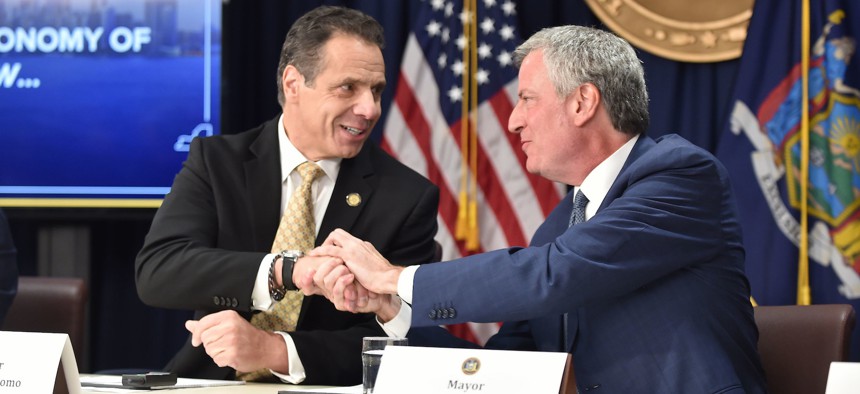Andrew Cuomo
Cuomo and de Blasio’s different COVID-19 containment approaches
The latest episode in their personal rivalry reflects competing ideas about how the coronavirus spreads.

Governor Cuomo and NYC Mayor Bill de Blasio have disagreed a lot throughout the coronavirus pandemic. Kevin P. Coughlin/Office of Governor Andrew M. Cuomo
Gov. Andrew Cuomo and New York City Mayor Bill de Blasio have disagreed on a lot during the coronavirus pandemic. There were the early squabbles about closing businesses and schools. Then there were disagreements on how to count the number of New Yorkers who died of COVID-19.
The central issue in the latest episode of their recurring political rivalry is whether the state should allow the city to close down businesses in areas of Brooklyn and Queens where cases of the coronavirus are surging. Cuomo has yet to approve those closures, though the mayor told reporters Tuesday that he is not done trying to close nonessential businesses starting Wednesday.
“I want fast action,” de Blasio said. “If we were not in this (state of) emergency status, I’d be taking the action myself.”
While politics undoubtedly plays a role in the ongoing impasse between the mayor and governor, their respective approaches to confronting the surge in cases suggests a wider gap in understanding how the coronavirus spreads.
New research shows that a small minority of people who have tested positive for COVID-19 are responsible for the vast majority of cases. By emphasizing social distancing and wearing masks at mass gatherings, the governor is looking to prevent a situation similar to a patient in South Korea who infected more than 5,000 people by attending a megachurch in February. That’s why the governor is not so concerned about closing businesses where just a few people might be interacting at a time.
This reflects what epidemiologists call the “stochastic” side of the coronavirus that makes it spread through large clusters that are statistically likely at a state or national scale, but also hard to pinpoint ahead of time. “There is a lot of randomness at times,”said Syra Madad, senior director of the systemwide special pathogens program office at New York City Health + Hospitals. “But there’s also factors that we know that enable the spread of COVID-19.” These reflect what is called the “deterministic” spread of the coronavirus through linear and predictable community spread.
This latter pattern is why the mayor has requested that the state allow the city to close local businesses, suspend outdoor and indoor dining as well as close schools in these hot spots. That appears to be straight out of the epidemiological playbook from the beginning of the pandemic when public health officials urged for widespread lockdowns to prevent infected patients from overwhelming the health care system.
To be sure, the approaches pursued by the mayor and governor also recognize the respective dangers of superspreading events and wider person-to-person spread. Cuomo has said the NYPD should help the state enforce mask-wearing in public while the potential for limiting clusters of cases is reflected in the mayor’s successful push to close schools.
Political factors are also undoubtedly at play. Cuomo is looking to avoid antagonizing the Orthodox Jewish community that has expressed concerns about being singled out by new efforts to enforce social distancing. De Blasio also appeared to be looking to force the governor’s hand by publicly announcing his proposal for school and business shutdowns before working out the details with the state. Such factors hardly help the governor and mayor get on the same page when it comes to keeping the ongoing clusters from stirring up a larger second wave of infections in the city.
The current situation in Brooklyn and Queens is complicated and requires a public health approach that strikes a balance between containing clusters of cases and battling community spread, according to Madad. While this can involve a lot of complicated public health concepts, it all comes down to simple public health measures, however differently they can be implemented, she added. “There’s so much heterogeneity,” she said of COVID-19 cases. “It’s just important that everybody wears a mask.”

